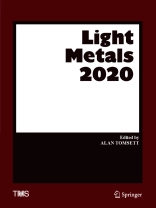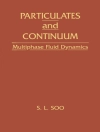The Light Metals symposia at the TMS Annual Meeting & Exhibition present the most recent developments, discoveries, and practices in primary aluminum science and technology. The annual Light Metals volume has become the definitive reference in the field of aluminum production and related light metal technologies. The 2020 collection includes papers from the following symposia:
• Alumina and Bauxite
• Aluminum Alloys, Processing and Characterization
• Aluminum Reduction Technology
• Cast Shop Technology
• Cast Shop Technology: Recycling and Sustainability Joint Session
• Electrode Technology for Aluminum Production
قائمة المحتويات
Part I Alumina and Bauxite.- 1 Impacts of Mineralogy on Soluble Phosphorus Concentrations During Low Temperature Processing of Jamaican Bauxites.- 3 Mineralogical Assessment of the Solid Phase Obtained.- 4 Low-Quality Aluminum-Containing Raw Materials: Experience, Problems and Prospects.- 5 Inhibition of Kaolinite Dissolution in Bayer Liquor Through Lithium Addition.- 6 Ionic Effect of Na Cl and KCl on the Flotation of Diaspore and Kaolinite Using Sodium Oleate as Collector.- 7 Quantifying the Effect of Seeds on Gibbsite Crystallization—Mathematical Modelling of Particle Size Distribution.- 8 Experimental Study on Flow Field Characteristics in Seed Precipitation Tank and Influence on Physical Properties of Al(OH)₃ Products.- 9 Application of Advanced Oxidative Process for Organic Compounds Removal from Bayer Liquor.- 10 A Review of Comprehensive Utilization of High-Iron Red Mud of China.- 11 Conversion Behavior of Iron-Containing Minerals in the Process of Dissolving High-Iron Bauxite by Starch Hydrothermal Method.- 12 Disc Magnetic Separator Applied to the Extraction of Magnetite in Bauxite Residue.- 13 Recovery of Iron from High-Iron Bayer Red Mud by Smelting Reduction.- 14 Bayer Process Towards the Circular Economy—Metal Recovery from Bauxite Residue.- 15 Bayer Process Towards the Circular Economy—Soil Conditioners from Bauxite Residue.- 16 Brazilian Bauxite Residue Physical–Chemical Characterization and Acidic Neutralization Potential.- 17 Effect of Concentrations and Pressures of CO₂ on Calcification–Carbonation Treatment of Bauxite Residue.- 18 Comprehensive Utilization of Red Mud Through the Recovery of Valuable Metals and Reuse of the Residue.- 19 A Review of Research on Alumina Extraction from High-Alumina Fly Ash and a New Method for Preparing Alumina by Electrotransformation.- 20 Effect of Sodium Alkali Concentration on Calcification–Carbonization Process.- Part II Aluminum Alloys, Processing and Characterization.- 21 Stress Characterization of Bore-Chilled Sand Cast Aluminum Engine Blocks in As-Cast and T7 Condition with Application of Neutron Diffraction.- 22 Molecular Dynamics Simulations of the Solidification of Pure Aluminium.- 23 Nanoindentation and Cavitation-Induced Fragmentation Study of Primary Al₃Zr Intermetallics Formed in Al Alloys.- 24 In Situ Neutron Diffraction Solidification Analyses of Rare Earth Reinforced Hypoeutectic and Hypereutectic Aluminum–Silicon Alloys.- 25 Influence of Ti B₂ Particles on Modification of Mg₂Si Eutectic Phase in Al–Zn–Si–Mg–Cu Cast Alloys.- 26 A Statistical Analysis to Study the Effect of Silicon Content, Surface Roughness, Droplet Size and Elapsed Time on Wettability of Hypoeutectic Cast Aluminum–Silicon Alloys.- 27 Aluminum Trace Elements Analyses Using Epsilon 1 Meso EDXRF Technique.- 28 Effect of Cooling Rate During Solidification of Aluminum–Chromium Alloy.- 29 Effects of Si on the Electrical Conductivity, Microhardness, Microstructure and Hot Tearing of Al–0.8Fe–0.5Mg–0.4Ni Alloys.- 30 The Efficacy of Replacing Metallic Cerium in Aluminum–Cerium Alloys with LREE Mischmetal.- 31 Effects of Sc and Y on the As-Cast Microstructure of AA6086.- 32 Ternary Interactions and Implications for Third Element Alloying Potency in Al–Ce-Based Alloys.- 33 Development and Analysis of Al7075 Alloy Materials Using Press and Sinter Processing.- 34 Formation of Rare Earth Intermetallics in Al–Cu Cast Alloys.- 35 Retrogression Forming and Reaging of AA7075-T6 Alclad to Produce Stampings with Peak Strength.- 36 High Cycle Fatigue Properties of the Zr-Modified Al–Si–Cu–Mg Alloy at Elevated Temperatures.- 37 Effect of Mo on Elevated-Temperature Low-Cycle Fatigue Behavior of Al-Si 356 Cast Alloy.- 38 State Parameter-Based Simulation of Temperature- and Strain Rate Dependent Flow Curves of Al-Alloys.- 39 Coarsening-Resistance of a Severely Deformed Al-0.2 Wt% Sc Alloy.- 40 The Effect of Modified Strain-Induced Melt Activation (Modified SIMA) Process on the Microstructure and Mechanical Propertiesof Al-7Si Alloy.- 41 Effect of Mg on Flow Behavior of Al–Mg Alloys and Its Constitutive Modeling Using Finite Element Analysis.- 42 Influence of Thermal Treatment and Design Parameters on the Fatigue Life of Automotive Control Arm Fabricated from A357 Semi-solid Alloy.- 43 The Formation of Al₆(Fe, Mn) Phase in Die-Cast Al–Mg Alloys.- 44 Spark Plasma Sintering of Graphene Nanoplatelets Reinforced Aluminium 6061 Alloy Composites.- 45 Effects of Mn and Mo Micro-additions on Al–Zr–Sc–Er–Si Mechanical Properties.- 46 Nanotreating High-Zinc Al–Zn–Mg–Cu Alloy by Ti C Nanoparticles.- 47 Microstructure and Mechanical Response of an Artificially Aged Al–Mg–Si Alloy: Experiments and Modeling.- 48 Effect of Zn Additions on the Mechanical Properties of High Strength Al–Si–Mg–Cu Alloys.- 49 Utilization of 3D Printed Materials in Expendable Pattern Casting Process.- 50 Hemming Evolution of 6xxx Aluminum Alloys in the Course of Natural Aging Following the Continuous Annealing.- 51 The Effect of Deformation Mode and Microstructure on the IGC Susceptibility of Al–Mg–Si–Cu Alloys for Automotive Applications.- 52 Evolution of Grain Refinement in AA5083 Sheet Metal Processed by ECAP.- 53 Mechanical and Microstructural Behavior of Dissimilar AA2014-T6 and AA7075-T6 Aluminium Alloys Joined by Friction Stir Welding.- 54 High Strength Nanotreated Filler Material for TIG Welding of AA6061.- 55 Optimization of Thermo-Mechanical Processes of Continuous Casting Products Using High Magnesium Aluminum Alloys in Automotive Industry Applications.- 56 Plastic Flow of AA6013-T6 at Elevated Temperatures and Subsequent Reaging to Regain Full Strength.- 57 Influence of Chemical Composition and Pre-deformation on the Age-Hardening Response of Al-Mg-Si Alloys.- 58 Hot Deformation and Die-Quenching of 6000-Series Alloys—The Effect of Quench-Interruption Temperature.- 59 Descriptors and Predictors: New Tools for the Predictive Modelling of Production Paths and the Properties of Aluminum-Based End-Products.-60 Effect of Extrusion Parameters on Microstructural and Mechanical Properties of EN AW 6063.- 61 Simulation Study on Equal Channel Right Angular Extrusion Process of Aluminum Alloy 6061.- 62 Characterization of Dynamic Material Property of Al Si10 Mg Aluminum Alloy Under High Strain Rate Compressive Loading.- 63 Current Efficiency for Direct Production of an Aluminium–Titanium Alloy by Electrolysis in a Laboratory Cell.- 64 Corrosion Inhibition Effect of Aloe Saponaria Gel on the Corrosion Resistance of Aluminum.- 65 Experimental Investigation of Mg Al₂O₄ Spinel Formation in Oxidation of Al–Mg Alloys.- 66 Impact of Dispersion Hardening by Alumina Nano Particles on Mechanical Properties of Al 1100.- 67 Investigation of Temperature Variation During Friction Drilling of 6082 and 7075 Al-Alloys.- 68 Study on the Anti-EMF of Al-Er Master Alloy Prepared by Er₂O₃ as Erbium Source.- Part III Aluminum Reduction Technology.- 69 Comparison Between Different Laminated Aluminum Busbars Expansion Joints in Terms of Mechanical Performance and Relative Costs.- 70 Demo Retrofit Study of a Chinese Inspired Cell Technology.- 71 Mass Transport by Waves on the Bath Metal Interface in Electrolysis Cell.- 72 Numerical Investigation of Flow Field Effect on Ledge Shape in Aluminum Reduction Cell by Coupled Thermo-Flow Model.- 73 Study of Heat Distribution Due to ACD Variations for Anode Setting.- 74 Anodic Incident Detection through Multivariate Analysis of Individual Anode Current Signals.- 75 Fault Detection and Diagnosis of Alumina Feeding System Using Individual Anode Current Measurement.- 76 Change of Anode Operation Pattern from Single to Double Staircase at Albras.- 77 An Advanced Nonlinear Control Approach for Aluminum Reduction Process.- 78 Model Based Approach for Online Monitoring of Aluminum Production Process.- 79 Predictive Analytics for Enhancing Productivity of Reduction Cells.- 80 Restart of Shutdown Pots: Troubles, Solutions and Comparison with Normal Pots to Improve Results.- 81 Electrochemical Behaviour of Cu-Al Oxygen-Evolving Anodes in Low-Temperature Fluoride Melts and Suspensions.- 82 Alumina Concentration Measurements in Cryolite Melts.- 83 The Influence of Polarisation on the Wetting of Graphite in Cryolite-Alumina Melts.- 84 Oxidation Study of Zinc Sulfite on the Removal of Sulfur Dioxide from Aluminum Electrolysis Flue Gas by Zinc Oxide.- 85 Electrolysis of Low-temperature Suspensions: An Update.- 86 Adapting Modern Industrial Operation Parameters in a Standardized Laboratory Cell for Measuring Current Efficiency for Aluminium Deposition: Unexpected Challenges and Lessons Learned.- 87 Aluminium Smelter Crust—Phase Distribution and Structure Analysis of Top Zone Layer.- 88 Influence of Anode Cover Material Particle Size Composition on Its Physical Property and Insulation Performance.- 89 Lab Scale Experiments on Alumina Raft Formation.- 90 Mass- and Heat Transfer During Dissolution of Alumina.- 91 The Rate of HF Formation During Addition of Alumina to Na F-Al F₃ Melts.- 92 Validation of the Gravimetric Method to Properly Follow Alumina Dissolution in Cryolitic Bath.- 93 Development of a Mathematical Model to Simulate Raft Formation.- 94 Efficient Alumina Handling.- 95 Status Analysis of Particle Size Distribution and Attrition Index of the Smelter Grade Alumina.- 96 The Effect of Hard Scale Deposition on the Wall Heat Flux of a Cold Finger.- 97 The Application of Intelligent Breaking and Feeding Technology for Aluminium Reduction Pot.- 98 Reducing the Carbon Footprint: Aluminium Smelting with Changing Energy Systems and the Risk of Carbon Leakage.- 99 Measurement System for Fugitive Emissions in Primary Aluminium Electrolysis.- 100 Validation of QCL CF₄ Gas Analyzer for Sensitivity and Selectivity.- 101 A Laboratory Study of the HF Generation Potential of Particulate Fluorides from Cell Emissions.- 102 Method Development to Estimate Total Low Voltage and High Voltage PFC Emissions.- 103 Update on SO₂ Scrubbing Applied in Primary Aluminium Smelters.- 104 Optimization of a Gas Treatment Center Equipped with Extended Surface Bag Filters.- 105 Update on the Abart Gas Treatment and Alumina Handling at the Karmøy Technology Pilot.- 106 The Australian Energy Crisis, Its Impact on Domestic Aluminium Smelting and Potential Solutions.- 107 Recycling of the Flue Gas from Aluminium Electrolysis Cells.- 108 Utilization of Waste Heat for Pre-heating of Anodes.- 109 Toward Minimizing the of Co-evolution of PFC Emission in EGA Smelter.- 110 Development and Application of GP500+ Energy Saving Aluminum Reduction Cell.- Part IV Cast Shop Technology.- 111 Hands-Free Casting at AMAG Casting Gmb H—It Is Possible!.- 112 User-Friendly Surveillance Tools to Prevent Bleed-Out During Cast Start.- 113 Beryllium Reduction Potential in Al Mg Cast Alloys.- 114 Accurate Real-Time Elemental (LIBS) Analysis of Molten Aluminum and Aluminum Alloys.- 115 Industrial Verification of Two Rotor Fluxing in Large Crucibles.- 116 Dynafeed: An Improved Crucible Transfer System.- 117 Metal Transfer from Furnace to Furnace—A Case Study.- 118 Heavily Loaded Areas in Aluminum Melting Furnaces and Possible Refractory Solutions.- 119 Mold Shape Control for Direct Chill Ingot Casting.- 120 Continuous Monitoring of Butt Curl Development During DC Casting—Development and Application.- 121 Constellium’s Mould Technology for Al Alloy Slab DC Casting.- 122 Fluid Flow Analyses and Meniscus Behavior During the Horizontal Single Belt Casting (HSBC) of Aluminum Alloy AA6111 Strips.- 123 Effect of Water Flow Distribution on the Performance of Aluminium Small-Form Ingot Chains.- 124 Small Scale Oxidation Experiments on Al Mg Alloys in Various Gas Fired Furnace Atmospheres.- 125 Study of the Oxidation of an Al-5Mg Alloy in Various Industrial Melting Furnace Atmospheres.- 126 Batscan™, Constellium In-melt Ultrasonic Inclusion Detector: Industrial Performance.- 127 Benchmark and Practical Application of State of the Art Hydrogen Monitoring.- 128 Molten Aluminum Quality Evaluations for Thin Foil Products.- 129 Industrial Verification of One- and Two-Chamber Siphon Degassing.- 130 Evaluation of CFF and BPF in Pilot Scale Filtration Tests.- 131 Dynaprime Filtration Technology Experience at Alcoa Baie-Comeau.- 132 Improving Ultrasonic Melt Treatment Efficiency Through Flow Management: Acoustic Pressure Measurements and Numerical Simulations.- 133 Impact of Ti B₂ Particle Size Distribution on Grain Refining Effectiveness.- 134 Effect of Nucleant Particle Size Distribution on the Grain Refining Efficiency of 7xxx Alloys.- 135 Impact of Transition-Metal Elements on Grain Refiner Performance in AA6061.- 136 Application Ultrasonic Technology Processing for Aluminum Treatment While Casting Slabs on Industrial Equipment of UC RUSAL.- 137 Influence of Liquid Jet Stirring and In-Situ Homogenization on the Intermetallics Formation During DC Casting of a 6xxx Al Alloy Rolling Ingot.- 138 Digital Manufacturing for Foundries 4.0.- 139 Integrating Fluid Simulation with Virtual Die Casting Machine for Industry 4.0 and Operator Training.- 140 Numerical Simulation of Wire Rod Casting of AA1370 and AA6101 Alloys.- 141 Influence of Nozzle Shape on Near-Surface Segregation Formation During Twin-Roll Casting of Aluminum Strips.- 142 Effect of Ultrasonic Treatment on the Eutectic Phase and Cu Content in the Al Matrix of Large-Scale 2219 Al Alloy Ingot.- 143 Influence of Alloying Additives on the Electrochemical Behavior of Cast Al-5Zn Alloys.- 144 Thermal Analysis and Microstructure of Al-12%Si-2.5%Cu-0.4%Mg Cast Alloy with Ce and/or La Rare Earth Metals.- 145 Numerical Simulation of Temperature Field in 6061 Aluminum Alloy Vertical Twin-Roll Casting Process.- Part V Cast Shop Technology: Recycling and Sustainability Joint Session.- 146 Constellium R&D Approach in Recycling, From Lab to Industrial Scale.- 147 Representative Sampling, Fractionation and Melting of Al-Scrap.- 148 Recycling of Aluminium from Mixed Household Waste.- 149 An Assessment of Recyclability of Used Aluminium Coffee Capsules.- 150 Fractional Solidification for Purification of Recycled Aluminium Alloys.- 151 A Rapid Method of Determining Salt Flux Melting Point and Composition.- 152 Recovery of Aluminium Metal Using Ultrasonic Technique and Production of Al–Si Hypereutectic Alloys from 6063 Alloy’s Black Dross Using Silicon Lumps and Flux.- 153 Automatic Skimming Procedure for Reducing Aluminium Losses and Maintaining the Uniform Quality of the Molten Metal.- 154 Evaluation of the Effect of CO₂ Cover Gas on the Rate of Oxidation of an Al Mg Si Alloy.- Part VI Electrode Technology for Aluminum Production.- 155 The Development of Anode Shape, Size and Assembly Designs—Past, Present and Future Needs.- 156 10 Years of Anode Research and Development: Alcoa and Université Laval Experience.- 157 Carbon Anode Raw Materials—Where Is the Cutting Edge?.- 158 Solids Flow Considerations and Their Impact in Smelter Carbon Plant Operations and Product Quality.- 159How to Improve the Environmental Efficiency of the Hall-Heroult Process While Producing and Using Carbon Anodes.- 160 Trends in Anode Carbon Production Projects.- 161 Development of a Soft Sensor for Detecting Overpitched Green Anodes.- 162 Diffusion Measurements of CO₂ Within Carbon Anodes for Aluminium Smelting.- 163 Testing of SERMA Technology on Industrial Anodes for Quality Control for Aluminum Production.- 164 Modelling of Gas Injection on Anode Baking Furnace and Application to Operations.- 165 Higher Baking and Production Levels in Anode Baking Furnaces and Associated Challenges.- 166 Major Reconstruction of Central Casing of Open Top Baking Furnace with a View to Increase Its Lifespan and Reduce the Total Costs Comparing to Full Reconstruction.- 167 Regulation and Management of Anode Baking Furnace Production Cycle During Green Anode Crisis.- 168 Sustainable Spent Pot Line Management Guidance.- 169 Purification of Graphite by Thermal Vacuum Treatment of Spent Potlining.- 170 The LCL&L Process: A Sustainable Solution for the Treatment and Recycling of Spent Pot Lining.- 171 Experimental Study on the Collecting Agent for Spent Potlining Flotation Index Optimization.- 172 Environmental Benefits of Using Spent Pot Lining (SPL) in Cement Production.- 173 Characteristic Analysis of Hazardous Waste from Aluminum Reduction Industry.- 174 Energy Saving in Hall–Héroult Cell by Optimization of Anode Assembly Design.- 175 High Temperature Creep Behaviour of Carbon-Based Cathode Material for Aluminum Electrolysis.- 176 Redesigning of Current Carrying Conductor—The Energy Reduction Initiative in Low Amperage Hall-Héroult Cell.- 177 Ready-to-Use Cathodes for the Hall-Héroult Process.- 178 Mechanism Understanding of Sodium Penetration into Anthracite Cathodes: A Perspective from Diffusion Coefficients.- 179 Anhydrous Carbon Pellets—An Engineered CPC Raw Material.- 180 Influence of Particle Shape and Porosity on the Bulk Density of Anode Grade Petroleum Coke.- 181 An EXAFS and XANES Study of V, Ni, and Fe Speciation in Cokes for Anodes Used in Aluminum Production.- 182 Additive Selection for Coal Tar Pitch Modification in Aluminium Industry.- 183 Charcoal and Use of Green Binder for Use in Carbon Anodes in the Aluminium Industry.












